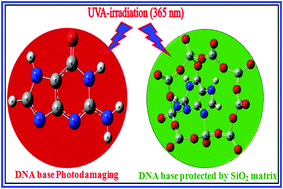Experimental and first-principles investigation of the adsorption and entrapping of guanine with SiO2 clusters of sol–gel silicate material for understanding DNA photodamage
Abstract
We report a first principles density functional theoretical (DFT) investigation of guanine (G) adsorption onto SiO2 clusters, viz., Si2O4, Si3O6, Si4O8 and Si5O10 in terms of geometry, binding energy (EB), binding site, energy gap (Eg), and electronic and spectral properties. Guanine entrapped within a Si9O18 cluster was also studied in terms of geometry, energy gap (Eg), electronic and spectral properties. We observed that the most stable forms of the cluster were Si5O10 and Si9O18. Guanine adsorbed onto SiO2 (G–SiO2) and guanine entrapped within SiO2 (GE–SiO2) were analyzed by the B3LYP/LanL2DZ method. The HOMO–LUMO energies illustrate that charge transfer from ligand to metal (L → M) occurs in G–SiO2 clusters as guanine to SiO2. The composite of guanine with nanostructured silica material was prepared by simple precipitation and chemical sol–gel processes. The prepared G–SiO2 and GE–SiO2 composites were characterized by FT-IR and FE-SEM with EDX analysis. The resulting experimental evidence is included for better understanding the guanine adsorption and entrapment. The adsorption and entrapping of G–SiO2 and GE–SiO2 was also confirmed by UV-vis spectroscopy. Experimental results are compared with the DFT results. Furthermore, the sol–gel silicate material used to protect the DNA base (guanine) from UVA-irradiation has been highlighted.


 Please wait while we load your content...
Please wait while we load your content...